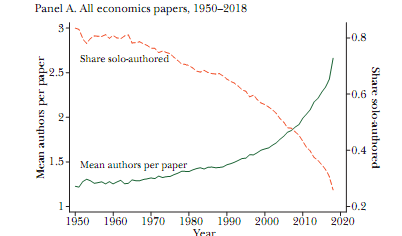
As new PhD students start to look forward to their first year, short 🧵 on challenges in collaboration in grad school (and its potentially gendered dimensions).
Many people advise grad students to rely on their classmates: first in coursework, later on projects / as coauthors.
Many people advise grad students to rely on their classmates: first in coursework, later on projects / as coauthors.
I endorse that advice! But it can also be hard to follow. I attended two grad programs (MPhil and PhD) and had similar experiences in both. There were large, energetic, overlapping-networks problem set groups that formed quickly.
They were mostly dominated by men (unsurprisingly; econ grad programs are mostly dominated by men) and, to describe it neutrally, had a fast-paced style. Always an introvert who was becoming more so, I was uncomfortable and anxious about trying to participate.
My math and programming background was relatively weak, and fair to say I was wrestling with my overall level of interest in economics. At Oxford, I wouldn’t even work in the same library as my classmates; I did occasionally compare psets with 1 or 2 people.
In my PhD, I had a small and awesome pset group (hi @ElizaForsythe!) That helped a lot. Still, I was certainly out of the loop; my network was thin, and continued to be thin as I moved into dissertation writing and the challenges of this pattern became more obvious.
I didn’t share that much, didn’t get that much feedback; socializing with classmates often made me anxious. At the time I graduated, I had only one project joint with a cohort-mate. Later added 2 more with other classmates.
But, my network is still mostly populated with connections from much later. Those connections are awesome (as are my coauthors from MIT)! But, I’m aware that I missed out on a lot, particularly early on.
My suggestions? Not sure! It’s great to jump into as many networks as you can in a PhD program, and work a lot with classmates. I am the first to say that can be challenging, and I think this is true particularly for women and, I imagine, for URM or first-gen students.
I gravitated toward very compact groups, mostly with other women, where I felt more comfortable; this has costs and benefits. Introverts, consider seeking out other quieter classmates at first to work with or even chat with (believe me, there are others out there).
This might be a place to build confidence and then branch out (unfortunately I largely didn’t do the latter).
Another option: just set very concrete, specific goals. At some point I had the goal of asking one question per weekly grad student lunch.
Another option: just set very concrete, specific goals. At some point I had the goal of asking one question per weekly grad student lunch.
As ridiculous as it sounds, it was unbelievably hard, but I did largely stick to it. I wish I had set other similar goals around getting feedback from classmates, considering joint projects, proposing ideas. I still use the minimal-goal strategy sometimes today, when needed.
Hope this helps for those starting grad school and thinking about how to benefit from as well as enjoy it. 100% true that it's easier with friends, but if you find it hard to make those friends sometimes: you're not the only one!
I always forget: #EconTwitter
• • •
Missing some Tweet in this thread? You can try to
force a refresh





